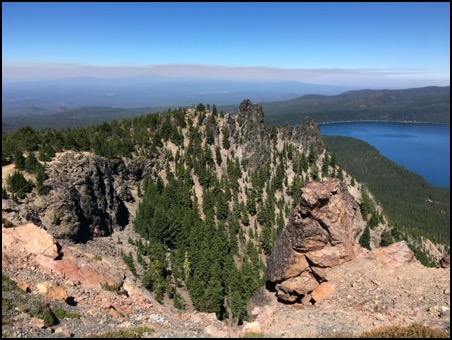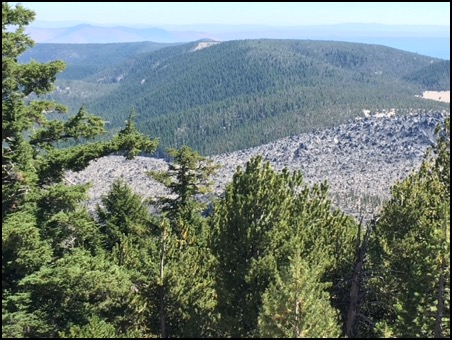Pacific Northwest
Newberry Volcano
22/01/23 13:20 Filed in: Travel
Have you ever heard of the Newberry Volcano?
The shield-shaped stratovolcano is located about 20 miles south of Bend, Oregon, and is one of the largest and most hazardous active volcanoes in the United States.
It is designated as a “very high threat” volcano in a recent assessment by the U.S. Geological Survey, as are the Big Island volcanoes of Mauna Loa and Kīlauea.
Newberry Volcano has been active for more than 530,000 years, most recently 1,300 years ago.
Lava flows erupted at Newberry cover an area larger than Rhode Island. Powerful explosive eruptions sent volcanic ash into Idaho and the San Francisco Bay Area. A deep caldera indents its summit, hosting a flow of obsidian and thick beds of explosive pumice…
Newberry Volcano formed at the western end of the High Lava Plains, a broad volcanic region of basalt and rhyolite in southeastern Oregon that forms the northern sub-province of the extensional Basin and Range Province, best known in Nevada.
A link to the story is here.

Paulina Lake and caldera

Newberry caldera and lava flows
The shield-shaped stratovolcano is located about 20 miles south of Bend, Oregon, and is one of the largest and most hazardous active volcanoes in the United States.
It is designated as a “very high threat” volcano in a recent assessment by the U.S. Geological Survey, as are the Big Island volcanoes of Mauna Loa and Kīlauea.
Newberry Volcano has been active for more than 530,000 years, most recently 1,300 years ago.
Lava flows erupted at Newberry cover an area larger than Rhode Island. Powerful explosive eruptions sent volcanic ash into Idaho and the San Francisco Bay Area. A deep caldera indents its summit, hosting a flow of obsidian and thick beds of explosive pumice…
Newberry Volcano formed at the western end of the High Lava Plains, a broad volcanic region of basalt and rhyolite in southeastern Oregon that forms the northern sub-province of the extensional Basin and Range Province, best known in Nevada.
A link to the story is here.

Paulina Lake and caldera

Newberry caldera and lava flows
Comments
Oldest Projectile Points
08/01/23 11:50 Filed in: History
In the local news today from Oregon State University…
OSU archaeology teams have carried out expeditions in west central Idaho for more than a decade, unearthing clues about life at Cooper's Ferry, along the Salmon River canyon.They have uncovered tools that add to a new understanding of the timeline of human life in the Americas - projectile points (or arrowheads as we call them).
The projectile points, or spear tips; razor sharp and ranging from half an inch to two inches long, that are so telling about the people who came here to hunt, to fish and to gather. They are about 3000 years older than what had been found before.
“This record is notable because now we realize it extends back to 16,000 years ago or probably a little earlier,” said OSU Anthropology Professor Loren Davis who has led expeditions of students to Cooper's Ferry for the duration of the project.
In 2019 they found bones and other items that gave them evidence of human life arriving here roughly 3000 years sooner than was previously believed.
Now carbon dating of these sharp hunting tools confirms it — and shows how advanced those native peoples were early on.
“Something in your hand that's that old, and to think about somebody actually took a block of rock through a series of steps, turned it into a spear point that I have in my hand is really pretty amazing,” said Davis.
In collaboration with the Nez Perce Tribe and the Bureau of Land Management (BLM), Davis and more than 200 students have spent thousands of hours carefully clearing the dirt, discovering signs of the first human life in the Americas, right here in the Pacific Northwest.
OSU archaeology teams have carried out expeditions in west central Idaho for more than a decade, unearthing clues about life at Cooper's Ferry, along the Salmon River canyon.They have uncovered tools that add to a new understanding of the timeline of human life in the Americas - projectile points (or arrowheads as we call them).
The projectile points, or spear tips; razor sharp and ranging from half an inch to two inches long, that are so telling about the people who came here to hunt, to fish and to gather. They are about 3000 years older than what had been found before.
“This record is notable because now we realize it extends back to 16,000 years ago or probably a little earlier,” said OSU Anthropology Professor Loren Davis who has led expeditions of students to Cooper's Ferry for the duration of the project.
In 2019 they found bones and other items that gave them evidence of human life arriving here roughly 3000 years sooner than was previously believed.
Now carbon dating of these sharp hunting tools confirms it — and shows how advanced those native peoples were early on.
“Something in your hand that's that old, and to think about somebody actually took a block of rock through a series of steps, turned it into a spear point that I have in my hand is really pretty amazing,” said Davis.
In collaboration with the Nez Perce Tribe and the Bureau of Land Management (BLM), Davis and more than 200 students have spent thousands of hours carefully clearing the dirt, discovering signs of the first human life in the Americas, right here in the Pacific Northwest.

